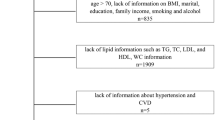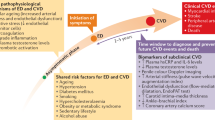Abstract
The possible relationship between erectile dysfunction and the later occurrence of cardiovascular disease while biologically plausible has been evaluated in only a few studies. Our objective is to determine the relation between ED as defined by a single question on erectile rigidity and the later occurrence of myocardial infarction, stroke and sudden death in a population-based cohort study. In Krimpen aan den IJssel, a municipality near Rotterdam, all men aged 50–75 years, without cancer of the prostate or the bladder, without a history of radical prostectomy, neurogenic bladder disease, were invited to participate for a response rate of 50%. The answer to a single question on erectile rigidity included in the International Continence Society male sex questionnaire was used to define the severity of erectile dysfunction at baseline. Data on cardiovascular risk factors at baseline (age smoking, blood pressure, total- and high-density lipoprotein cholesterol, diabetes) were used to calculate Framingham risk scores. During an average of 6.3 years of follow-up, cardiovascular end points including acute myocardial infarction, stroke and sudden death were determined. Of the 1248 men free of CVD at baseline, 258 (22.8%) had reduced erectile rigidity and 108 (8.7%) had severely reduced erectile rigidity. In 7945 person-years of follow-up, 58 cardiovascular events occurred. In multiple variable Cox proportional hazards model adjusting for age and CVD risk score, hazard ratio was 1.6 (95% confidence interval (CI): 1.2–2.3) for reduced erectile rigidity and 2.6 (95% CI: 1.3–5.2) for severely reduced erectile rigidity. The population attributable risk fraction for reduced and severely reduced erectile rigidity was 11.7%. In this population-based study, a single question on erectile rigidity proved to be a predictor for the combined outcome of acute myocardial infarction, stroke and sudden death, independent of the risk factors used in the Framingham risk profile.
This is a preview of subscription content, access via your institution
Access options
Subscribe to this journal
Receive 8 print issues and online access
$259.00 per year
only $32.38 per issue
Buy this article
- Purchase on Springer Link
- Instant access to full article PDF
Prices may be subject to local taxes which are calculated during checkout



Similar content being viewed by others
References
Johannes CB, Araujo AB, Feldman HA, Derby CA, Kleinman KP, McKinlay JB . Incidence of erectile dysfunction in men 40–69 years old: longitudinal results from the Massachusetts male aging study. J Urol 2000; 163: 460–463.
Prins J, Blanker MH, Bohnen AM, Thomas S, Bosch JL . Prevalence of erectile dysfunction: a systematic review of population-based studies. Int J Impot Res 2002; 14: 422–432.
Schouten BW, Bosch JL, Bernsen RM, Blanker MH, Thomas S, Bohnen AM . Incidence rates of erectile dysfunction in the Dutch general population. Effects of definition, clinical relevance and duration of follow-up in the Krimpen Study. Int J Impot Res 2005; 17: 58–62.
Kirby M, Jackson G, Betteridge J, Friedli K . Is erectile dysfunction a marker for cardiovascular disease? Int J Clin Pract 2001; 55: 614–618.
Blanker MH, Bohnen AM, Groeneveld FP, Bernsen RM, Prins A, Thomas S et al. Correlates for erectile and ejaculatory dysfunction in older Dutch men: a community-based study. J Am Geriatr Soc 2001; 49: 436–442.
Ponholzer A, Temml C, Obermayr R, Wehrberger C, Madersbacher S . Is erectile dysfunction an indicator for increased risk of coronary heart disease and stroke? Eur Urol 2005; 48: 512–518, discussion 517–8.
Bacon CG, Mittleman MA, Kawachi I, Giovannucci E, Glasser DB, Rimm EB . Sexual function in men older than 50 years of age: results of the health professionals follow-up study. Ann Intern Med 2003; 139: 161–168.
Eaton CB, Liu YL, Mittleman MA, Miner M, Glasser DB, Rimm EB . A retrospective study of the relationship of biomarkers for atherosclerosis and erectile dysfunction in 988 men. Int J Impot Res 2007; 19: 218–225.
Gazzaruso C, Giordanetti S, De Amici E, Bertone G, Falcone C, Geroldi D et al. Relationship between erectile dysfunction and silent myocardial ischemia in apparently uncomplicated type 2 diabetic patients. Circulation 2004; 110: 22–26.
Kirby M, Jackson G, Simonsen U . Endothelial dysfunction links erectile dysfunction to heart disease. Int J Clin Pract 2005; 59: 225–229.
Roumeguere T, Wespes E, Carpentier Y, Hoffmann P, Schulman CC . Erectile dysfunction is associated with a high prevalence of hyperlipidemia and coronary heart disease risk. Eur Urol 2003; 44: 355–359.
Thompson IM, Tangen CM, Goodman PJ, Probstfield JL, Moinpour CM, Coltman CA . Erectile dysfunction and subsequent cardiovascular disease. JAMA 2005; 294: 2996–3002.
Schouten B, Bohnen AM, Thomas S . Erectile dysfunction and incidence of cardiovascular disease. JAMA 2006; 295: 1999.
Blanker MH, Prins J, Bosch JL, Schouten BW, Bernsen RM, Groeneveld FP et al. Loss to follow-up in a longitudinal study on urogenital tract symptoms in Dutch older men. Urol Int 2005; 75: 30–37.
Blanker MH, Groeneveld FP, Prins A, Bernsen RM, Bohnen AM, Bosch JL . Strong effects of definition and nonresponse bias on prevalence rates of clinical benign prostatic hyperplasia: the Krimpen study of male urogenital tract problems and general health status. BJU Int 2000; 85: 665–671.
Tubaro A, Polito M, Giambroni L, Famulari C, Gange E, Ostardo E . Sexual function in patients with LUTS suggestive of BPH. Eur Urol 2001; 40 (Suppl 1): 19–22.
Stijnen T, Arends LR . [Roaming through methodology. XVI. What to do about missing data] Dwalingen in de methodologie. XVI. Wat te doen met ontbrekende waarnemingen? Ned Tijdschr Geneeskd 1999; 143: 1996–2000.
Eijkelenburg-Waterreus van Y, Schellevis F, Bakker de D, Tiersma W, Westert G . Gegevens in het elektronisch medisch dossier: bruikbaar voor het optimaliseren van de probleemlijst? Huisarts en Wetenschap 2001; 44: 377–380.
Lamberts H, Wood M . ICPC: International Classification of Primary Care. Oxford University Press: Oxford, 1987.
Miller GC, Britt H . A new drug classification for computer systems: the ATC extension code. Int J Biomed Comput 1995; 40: 121–124.
Donovan JL, Abrams P, Peters TJ, Kay HE, Reynard J, Chapple C et al. The ICS-‘BPH’ Study: the psychometric validity and reliability of the ICSmale questionnaire. Br J Urol 1996; 77: 554–562.
Anderson KM, Odell PM, Wilson PW, Kannel WB . Cardiovascular disease risk profiles. Am Heart J 1991; 121: 293–298.
Antithrombotic Trialists C . Collaborative meta-analysis of randomised trials of antiplatelet therapy for prevention of death, myocardial infarction, and stroke in high risk patients. BMJ 2002; 324: 71–86.
Rubin D . Multiple Imputation for Nonresponse in Surveys. John Wiley & Sons Inc: New York, 1987.
Faris PD, Ghali WA, Brant R, Norris CM, Galbraith PD, Knudtson ML et al. Multiple imputation versus data enhancement for dealing with missing data in observational health care outcome analyses. J Clin Epidemiol 2002; 55: 184–191.
Landrum MB, Becker MP . A multiple imputation strategy for incomplete longitudinal data. Stat Med 2001; 20: 2741–2760.
Odell PM, Anderson KM, Kannel WB . New models for predicting cardiovascular events. J Clin Epidemiol 1994; 47: 583–592.
Wilson PW, D'Agostino RB, Levy D, Belanger AM, Silbershatz H, Kannel WB . Prediction of coronary heart disease using risk factor categories. Circulation 1998; 97: 1837–1847.
Conroy RM, Pyorala K, Fitzgerald AP, Sans S, Menotti A, De Backer G et al. Estimation of ten-year risk of fatal cardiovascular disease in Europe: the SCORE project. Eur Heart J 2003; 24: 987–1003.
SAS/BASE® and SAS/STAT® software version 9.1 TS Level 03M0 of the SAS system for Windows. [the SAS System for Windows program] 9.1 service pack 3 version. Copyright© 2003 SAS Institute Inc. Cary, NC, USA.
Woodward M, Bassetti WHC (eds). Epidemiology Study Design and data analysis, Texts in Staitistical Science 2nd edn. Chapman and Hall CRC Press: Boca Raton, 2004.
Blanker MH, Bosch JL, Groeneveld FP, Bohnen AM, Prins A, Thomas S et al. Erectile and ejaculatory dysfunction in a community-based sample of men 50 to 78 years old: prevalence, concern, and relation to sexual activity. Urology 2001; 57: 763–768.
Kostis JB, Jackson G, Rosen R, Barrett-Connor E, Billups K, Burnett AL et al. Sexual dysfunction and cardiac risk (the Second Princeton Consensus Conference). Am J Cardiol 2005; 96: 85M–93M.
Derby CA, Araujo AB, Johannes CB, Feldman HA, McKinlay JB . Measurement of erectile dysfunction in population-based studies: the use of a single question self-assessment in the Massachusetts Male Aging Study. Int J Impot Res 2000; 12: 197–204.
Acknowledgements
Baseline was funded by an unconditional grant from SUWO (Foundation for urologic scientific research). Follow up was partly funded by an unconditional grant of Pfizer Inc.
Author information
Authors and Affiliations
Corresponding author
Additional information
Take Home Message: Negative answers on the question ‘Do you get erections?’ increase the risk of cardiovascular disease by a factor between one and a half and two and a half. This appears to be of the same magnitude as the classical risk factors diabetes and smoking.
Rights and permissions
About this article
Cite this article
Schouten, B., Bohnen, A., Bosch, J. et al. Erectile dysfunction prospectively associated with cardiovascular disease in the Dutch general population: results from the Krimpen Study. Int J Impot Res 20, 92–99 (2008). https://doi.org/10.1038/sj.ijir.3901604
Received:
Revised:
Accepted:
Published:
Issue Date:
DOI: https://doi.org/10.1038/sj.ijir.3901604
Keywords
This article is cited by
-
Prevalence of sexual dysfunction and pursuit of sexual medicine evaluation among male physicians—a survey
International Journal of Impotence Research (2024)
-
Interactions between erectile dysfunction, cardiovascular disease and cardiovascular drugs
Nature Reviews Cardiology (2022)
-
Effect of testosterone replacement therapy on sexual function and glycemic control among hypogonadal men with type 2 diabetes mellitus
International Journal of Impotence Research (2019)
-
Two Birds with One Stone: Regular Use of PDE5 Inhibitors for Treating Male Patients with Erectile Dysfunction and Cardiovascular Diseases
Cardiovascular Drugs and Therapy (2019)
-
Emerging Treatments for Erectile Dysfunction: a Review of Novel, Non-surgical Options
Current Urology Reports (2019)



